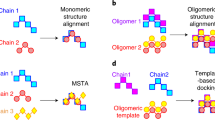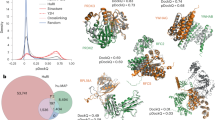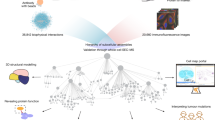Abstract
Interactions between macromolecules, such as proteins and nucleic acids, are essential for cellular functions. Experimental methods can fail to provide all the information required to fully model biomolecular complexes at atomic resolution, particularly for large and heterogeneous assemblies. Integrative computational approaches have, therefore, gained popularity, complementing traditional experimental methods in structural biology. Here, we introduce HADDOCK2.4, an integrative modeling platform, and its updated web interface (https://wenmr.science.uu.nl/haddock2.4). The platform seamlessly integrates diverse experimental and theoretical data to generate high-quality models of macromolecular complexes. The user-friendly web server offers automated parameter settings, access to distributed computing resources, and pre- and post-processing steps that enhance the user experience. To present the web server’s various interfaces and features, we demonstrate two different applications: (i) we predict the structure of an antibody–antigen complex by using NMR data for the antigen and knowledge of the hypervariable loops for the antibody, and (ii) we perform coarse-grained modeling of PRC1 with a nucleosome particle guided by mutagenesis and functional data. The described protocols require some basic familiarity with molecular modeling and the Linux command shell. This new version of our widely used HADDOCK web server allows structural biologists and non-experts to explore intricate macromolecular assemblies encompassing various molecule types.
Key points
-
HADDOCK is an integrative modeling approach that can combine experimental and predicted information to guide the structure prediction of biomolecular complexes, including protein–protein, protein–ligand, protein–oligosaccharide and protein–nucleic acid complexes, starting from the individual structures of their components.
-
HADDOCK uses ambiguous interaction restraints to drive the docking process and supports various experimental data, including mutagenesis, NMR and cryo-EM data.
This is a preview of subscription content, access via your institution
Access options
Access Nature and 54 other Nature Portfolio journals
Get Nature+, our best-value online-access subscription
$32.99 / 30 days
cancel any time
Subscribe to this journal
Receive 12 print issues and online access
$259.00 per year
only $21.58 per issue
Buy this article
- Purchase on SpringerLink
- Instant access to full article PDF
Prices may be subject to local taxes which are calculated during checkout




Similar content being viewed by others
Data availability
All data used in the procedures are available at a dedicated GitHub repository54: https://github.com/haddocking/haddock24-protocol.
Code availability
pdb-tools is available at https://github.com/haddocking/pdb-tools (Apache 2.0)55, and the HADDOCK2.4 web service application (used in the described protocols) is available at https://wenmr.science.uu.nl/haddock2.4.
References
van Noort, C. W., Honorato, R. V. & Bonvin, A. M. J. J. Information-driven modeling of biomolecular complexes. Curr. Opin. Struct. Biol. 70, 70–77 (2021).
Masrati, G. et al. Integrative structural biology in the era of accurate structure prediction. J. Mol. Biol. 433, 167127 (2021).
Rout, M. P. & Sali, A. Principles for integrative structural biology studies. Cell 177, 1384–1403 (2019).
Jumper, J. et al. Highly accurate protein structure prediction with AlphaFold. Nature 596, 583–589 (2021).
Perrakis, A. & Sixma, T. K. AI revolutions in biology. EMBO Rep. 22, e54046 (2021).
Li, S. et al. Recent advances in predicting protein–protein interactions with the aid of artificial intelligence algorithms. Curr. Opin. Struct. Biol. 73, 102344 (2022).
Varadi, M. et al. AlphaFold Protein Structure Database: massively expanding the structural coverage of protein-sequence space with high-accuracy models. Nucleic Acids Res. 50, D439–D444 (2021).
The UniProt Consortium. UniProt: the Universal Protein Knowledgebase in 2023. Nucleic Acids Res. 51, D523–D531 (2022).
Vakser, I. A. & Deeds, E. J. Computational approaches to macromolecular interactions in the cell. Curr. Opin. Struct. Biol. 55, 59–65 (2019).
wwPDB Consortium. Protein Data Bank: the single global archive for 3D macromolecular structure data. Nucleic Acids Res. 47, D520–D528 (2018).
Sali, A. et al. Outcome of the First wwPDB Hybrid/Integrative Methods Task Force Workshop. Structure 23, 1156–1167 (2015).
Vallat, B. et al. New system for archiving integrative structures. Acta Crystallogr. D. Struct. Biol. 77, 1486–1496 (2021).
Saponaro, A., Maione, V., Bonvin, A. & Cantini, F. Understanding docking complexes of macromolecules using HADDOCK: the synergy between experimental data and computations. Bio-Protoc. 10, e3793 (2020).
Roel-Touris, J., Jiménez-García, B. & Bonvin, A. M. J. J. Integrative modeling of membrane-associated protein assemblies. Nat. Commun. 11, 6210 (2020).
Ambrosetti, F., Jandova, Z. & Bonvin, A. M. J. J. Information-driven antibody–antigen modelling with HADDOCK. In: Methods in Molecular Biology Vol. 2552 (eds Tsumoto, K. & Kuroda, D.) 267–282 (Humana, 2023).
Ambrosetti, F., Jiménez-García, B., Roel-Touris, J. & Bonvin, A. M. J. J. Modeling antibody-antigen complexes by information-driven docking. Structure 28, 119–129.e2 (2020).
Trellet, M., van Zundert, G. & Bonvin, A. M. J. J. Structural bioinformatics, methods and protocols. Methods Mol. Biol. 2112, 145–162 (2020).
Koukos, P. I. & Bonvin, A. M. J. J. Integrative modelling of biomolecular complexes. J. Mol. Biol. 432, 2861–2881 (2020).
Rosell, M. & Fernández-Recio, J. Docking approaches for modeling multi-molecular assemblies. Curr. Opin. Struct. Biol. 64, 59–65 (2020).
Roel-Touris, J., Bonvin, A. M. J. J. & Jiménez-García, B. LightDock goes information-driven. Bioinformatics 36, 950–952 (2019).
Xia, B., Vajda, S. & Kozakov, D. Accounting for pairwise distance restraints in FFT-based protein–protein docking. Bioinformatics 32, 3342–3344 (2016).
Echartea, M. E. R., Ritchie, D. W. & de Beauchêne, I. C. Using restraints in EROS‐DOCK improves model quality in pairwise and multicomponent protein docking. Proteins 88, 1121–1128 (2020).
Dominguez, C., Boelens, R. & Bonvin, A. M. J. J. HADDOCK: a protein−protein docking approach based on biochemical or biophysical information. J. Am. Chem. Soc. 125, 1731–1737 (2003).
Tsaban, T. et al. Harnessing protein folding neural networks for peptide–protein docking. Nat. Commun. 13, 176 (2022).
Ghani, U. et al. Improved docking of protein models by a combination of Alphafold2 and ClusPro. Preprint at bioRxiv https://doi.org/10.1101/2021.09.07.459290 (2022).
Evans, R. et al. Protein complex prediction with AlphaFold-Multimer. Preprint at bioRxiv https://doi.org/10.1101/2021.10.04.463034 (2022).
Bryant, P. et al. Predicting the structure of large protein complexes using AlphaFold and Monte Carlo tree search. Nat. Commun. 13, 6028 (2022).
Burke, D. F. et al. Towards a structurally resolved human protein interaction network. Nat. Struct. Mol. Biol. 30, 216–225 (2023).
Baek, M. et al. Accurate prediction of protein structures and interactions using a three-track neural network. Science 373, 871–876 (2021).
Mirdita, M. et al. ColabFold: making protein folding accessible to all. Nat. Methods 19, 679–682 (2022).
Brünger, A. T. et al. Crystallography & NMR system: a new software suite for macromolecular structure determination. Acta Crystallogr. D. Biol. Crystallogr. 54, 905–921 (1998).
de Vries, S. J., van Dijk, M. & Bonvin, A. M. J. J. The HADDOCK web server for data-driven biomolecular docking. Nat. Protoc. 5, 883–897 (2010).
van Zundert, G. C. P. et al. The HADDOCK2.2 web server: user-friendly integrative modeling of biomolecular complexes. J. Mol. Biol. 428, 720–725 (2016).
Roel-Touris, J., Don, C. G., Honorato, R. V., Rodrigues, J. P. G. L. M. & Bonvin, A. M. J. J. Less is more: coarse-grained integrative modeling of large biomolecular assemblies with HADDOCK. J. Chem. Theory Comput. 15, 6358–6367 (2019).
Honorato, R. V., Roel-Touris, J. & Bonvin, A. M. J. J. MARTINI-based protein-DNA coarse-grained HADDOCKing. Front. Mol. Biosci. 6, 102 (2019).
Marrink, S. J., Risselada, H. J., Yefimov, S., Tieleman, D. P. & de Vries, A. H. The MARTINI force field: coarse grained model for biomolecular simulations. J. Phys. Chem. B 111, 7812–7824 (2007).
van Zundert, G. C. P. & Bonvin, A. M. J. J. Defining the limits and reliability of rigid-body fitting in cryo-EM maps using multi-scale image pyramids. J. Struct. Biol. 195, 252–258 (2016).
Neijenhuis, T., Keulen, S. Cvan & Bonvin, A. M. J. J. Interface refinement of low- to medium-resolution cryo-EM complexes using HADDOCK2.4. Structure 30, 476–484 (2021).
Koukos, P. I., Réau, M. & Bonvin, A. M. J. J. Shape-restrained modeling of protein–small-molecule complexes with high ambiguity driven DOCKing. J. Chem. Inf. Model 61, 4807–4818 (2021).
Honorato, R. V. et al. Structural biology in the clouds: the WeNMR-EOSC ecosystem. Front. Mol. Biosci. 8, 729513 (2021).
Chen, V. B. et al. MolProbity: all-atom structure validation for macromolecular crystallography. Acta Crystallogr. D. Biol. Crystallogr. 66, 12–21 (2010).
Schüttelkopf, A. W. & van Aalten, D. M. F. PRODRG: a tool for high-throughput crystallography of protein–ligand complexes. Acta Crystallogr. D. Biol. l Crystallogr. 60, 1355–1363 (2004).
Rose, A. S. et al. NGL viewer: web-based molecular graphics for large complexes. Bioinformatics 34, 3755–3758 (2018).
Jorgensen, W. L. & Tirado-Rives, J. The OPLS [optimized potentials for liquid simulations] potential functions for proteins, energy minimizations for crystals of cyclic peptides and crambin. J. Am. Chem. Soc. 110, 1657–1666 (1988).
Fernández-Recio, J., Totrov, M. & Abagyan, R. Identification of protein–protein interaction sites from docking energy landscapes. J. Mol. Biol. 335, 843–865 (2004).
Veerapandian, B. et al. Functional implications of interleukin‐1β based on the three‐dimensional structure. Proteins 12, 10–23 (1992).
Blech, M. et al. One target—two different binding modes: structural insights into gevokizumab and canakinumab interactions to interleukin-1β. J. Mol. Biol. 425, 94–111 (2013).
Rodrigues, J. P. G. L. M., Teixeira, J. M. C., Trellet, M. & Bonvin, A. M. J. J. pdb-tools: a swiss army knife for molecular structures. F1000Res. 7, 1961 (2018).
Mattiroli, F., Uckelmann, M., Sahtoe, D. D., van Dijk, W. J. & Sixma, T. K. The nucleosome acidic patch plays a critical role in RNF168-dependent ubiquitination of histone H2A. Nat. Commun. 5, 3291 (2014).
McGinty, R. K., Henrici, R. C. & Tan, S. Crystal structure of the PRC1 ubiquitylation module bound to the nucleosome. Nature 514, 591–596 (2014).
Bentley, M. L. et al. Recognition of UbcH5c and the nucleosome by the Bmi1/Ring1b ubiquitin ligase complex. EMBO J. 30, 3285–3297 (2011).
Blech, M. & Hoerer, S. Crystal structure of human IL-1beta in complex with therapeutic antibody binding fragment of gevokizumab. Available at https://www.rcsb.org/structure/4g6m (2012).
Basu, S. & Wallner, B. DockQ: a quality measure for protein-protein docking models. PLoS One 11, e0161879 (2016).
HADDOCK2.4 web server protocol data. GitHub https://github.com/haddocking/haddock24-protocol (2023).
pdb-tools. GitHub https://github.com/haddocking/pdb-tools (2024).
Eastman, P. et al. OpenMM 7: rapid development of high performance algorithms for molecular dynamics. PLoS Comput. Biol. 13, e1005659 (2017).
Tjandra, N., Omichinski, J. G., Gronenborn, A. M., Clore, G. M. & Bax, A. Use of dipolar 1H–15N and 1H–13C couplings in the structure determination of magnetically oriented macromolecules in solution. Nat. Struct. Biol. 4, 732–738 (1997).
Meiler, J., Blomberg, N., Nilges, M. & Griesinger, C. A new approach for applying residual dipolar couplings as restraints in structure elucidation. J. Biomol. NMR 16, 245–252 (2000).
Banci, L. et al. Paramagnetism-based restraints for Xplor-NIH. J. Biomol. NMR 28, 249–261 (2004).
Tjandra, N., Garrett, D. S., Gronenborn, A. M., Bax, A. & Clore, G. M. Defining long range order in NMR structure determination from the dependence of heteronuclear relaxation times on rotational diffusion anisotropy. Nat. Struct. Biol. 4, 443–449 (1997).
Acknowledgements
The authors acknowledge financial support from the European Union Horizon 2020, projects BioExcel (675728, 823830), from the EuroHPC Joint Undertaking and Sweden, Netherlands, Germany, Spain, Finland and Norway (101093290) and from the Dutch Foundation for Scientific Research (NWO) (TOP-PUNT grant 718.015.001). The FP7 WeNMR (261572), H2020 West-Life (675858), EOSC-hub (777536) and EGI-ACE (101017567) European e-Infrastructure projects are acknowledged for the use of the EGI infrastructure with the dedicated support of CESNET-MCC, INFN-LNL-2, NCG-INGRID-PT, TW-NCHC, CESGA, IFCA-LCG2, UA-BITP, TR-FC1-ULAKBIM, CSTCLOUD-EGI, IN2P3-CPPM, CIRMMP, SURFsara and NIKHEF and the additional support of the national GRID Initiatives of Belgium, France, Italy, Germany, the Netherlands, Poland, Portugal, Spain, UK, Taiwan and the US Open Science Grid.
Author information
Authors and Affiliations
Contributions
A.M.J.J.B. supervised the project. All authors contributed to the development of HADDOCK2.4 and the various protocols and types of molecules supported. R.V.H., M.E.T, B.J.-G., J.J.S. and P.I.K. contributed to the development of the web interface. A.M.J.J.B. and R.V.H. wrote the manuscript. All authors contributed to the manuscript editing and checking.
Corresponding author
Ethics declarations
Competing interests
The authors declare no competing interests.
Peer review
Peer review information
Nature Protocols thanks George Chiduza and Cedric Leyrat for their contribution to the peer review of this work.
Additional information
Publisher’s note Springer Nature remains neutral with regard to jurisdictional claims in published maps and institutional affiliations.
Related links
Key references using this protocol
de Vries, S. J. et al. Nat. Protoc. 5, 883–897 (2010): https://doi.org/10.1038/nprot.2010.32
Honorato, R. V. et al. Front. Mol. Biosci. 6, 102 (2019): https://doi.org/10.3389/fmolb.2019.00102
Ambrosetti, F. et al. Structure 28, 119–129.e2 (2020): https://doi.org/10.1016/j.str.2019.10.011
Extended data
Extended Data Fig. 1
Screenshots showing Steps 7–9 of Procedure 1.
Extended Data Fig. 2
Screenshots showing Steps 10–11 of Procedure 1.
Extended Data Fig. 3
Screenshots showing Steps 12–13 of Procedure 1.
Extended Data Fig. 4
Screenshots showing Steps 14–15 of Procedure 1.
Extended Data Fig. 5
Screenshots showing Step 20 of Procedure 1.
Supplementary Information
Supplementary Information
Supplementary Fig. 1
Rights and permissions
Springer Nature or its licensor (e.g. a society or other partner) holds exclusive rights to this article under a publishing agreement with the author(s) or other rightsholder(s); author self-archiving of the accepted manuscript version of this article is solely governed by the terms of such publishing agreement and applicable law.
About this article
Cite this article
Honorato, R.V., Trellet, M.E., Jiménez-García, B. et al. The HADDOCK2.4 web server for integrative modeling of biomolecular complexes. Nat Protoc 19, 3219–3241 (2024). https://doi.org/10.1038/s41596-024-01011-0
Received:
Accepted:
Published:
Issue date:
DOI: https://doi.org/10.1038/s41596-024-01011-0
This article is cited by
-
LncRNA CASC19 promotes pancreatic cancer progression by increasing PSPC1 protein stability and facilitating the oncogenic PSPC1/ β-Catenin pathway
Molecular Medicine (2025)
-
Functional and structural characterization of the human indolethylamine N-methyltransferase through fluorometric, thermal and computational docking analyses
Biology Direct (2025)
-
Immunoinformatics-Based development of a Multi-Epitope vaccine candidate targeting coinfection by Klebsiella pneumoniae and Acinetobacter baumannii
BMC Infectious Diseases (2025)
-
Molecular basis for the regulation of human phosphorylase kinase by phosphorylation and Ca2+
Nature Communications (2025)
-
Development of a self-assembling multimeric Bann-RBD fusion protein in Pichia pastoris as a potential COVID-19 vaccine candidate
Scientific Reports (2025)



